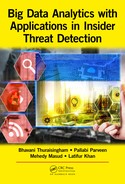0%
59Chapters
0-1Hours read
0kTotal Words
Table of Contents
- Cover
- Half Title
- Title Page
- Copyright Page
- Dedication
- Contents
- Preface
- Acknowledgments
- Permissions
- Authors
- Chapter 1: Introduction
- Part I: Supporting Technologies for BDMA and BDSP
- Introduction to Part I
- Chapter 2: Data Security and Privacy
- Chapter 3: Data Mining Techniques
- Chapter 4: Data Mining for Security Applications
- Chapter 5: Cloud Computing and Semantic Web Technologies
- 5.1 Introduction
- 5.2 Cloud Computing
- 5.3 Semantic Web
- 5.4 Semantic Web and Security
- 5.5 Cloud Computing Frameworks Based on Semantic Web Technologies
- 5.6 Summary and Directions
- References
- Chapter 6: Data Mining and Insider Threat Detection
- 6.1 Introduction
- 6.2 Insider Threat Detection
- 6.3 The Challenges, Related Work, and Our Approach
- 6.4 Data Mining for Insider Threat Detection
- 6.5 Comprehensive Framework
- 6.6 Summary and Directions
- References
- Chapter 7: Big Data Management and Analytics Technologies
- Conclusion to Part I
- Part II: Stream Data Analytics
- Introduction to Part II
- Chapter 8: Challenges for Stream Data Classification
- Chapter 9: Survey of Stream Data Classification
- Chapter 10: A Multi-Partition, Multi-Chunk Ensemble for Classifying Concept-Drifting Data Streams
- Chapter 11: Classification and Novel Class Detection in Concept-Drifting Data Streams
- Chapter 12: Data Stream Classification with Limited Labeled Training Data
- Chapter 13: Directions in Data Stream Classification
- Conclusion to Part II
- Part III: Stream Data Analytics for Insider Threat Detection
- Introduction to Part III
- Chapter 14: Insider Threat Detection as a Stream Mining Problem
- Chapter 15: Survey of Insider Threat and Stream Mining
- Chapter 16 Ensemble-Based Insider Threat Detection
- Chapter 17: Details of Learning Classes
- Chapter 18: Experiments and Results for Nonsequence Data
- Chapter 19: Insider Threat Detection for Sequence Data
- Chapter 20: Experiments and Results for Sequence Data
- Chapter 21: Scalability Using Big Data Technologies
- Chapter 22: Stream Mining and Big Data for Insider Threat Detection
- Conclusion to Part III
- Part IV: Experimental BDMA and BDSP Systems
- Introduction to Part IV
- Chapter 23: Cloud Query Processing System for Big Data Management
- Chapter 24: Big Data Analytics for Multipurpose Social Media Applications
- 24.1 Introduction
- 24.2 Our Premise
- 24.3 Modules of Inxite
- 24.4 Other Applications
- 24.5 Related Work
- 24.6 Summary and Directions
- References
- Chapter 25: Big Data Management and Cloud for Assured Information Sharing
- Chapter 26: Big Data Management for Secure Information Integration
- Chapter 27: Big Data Analytics for Malware Detection
- Chapter 28: A Semantic Web-Based Inference Controller for Provenance Big Data
- Conclusion to Part IV
- Part V: Next Steps for BDMA and BDSP
- Introduction to Part V
- Chapter 29: Confidentiality, Privacy, and Trust for Big Data Systems
- 29.1 Introduction
- 29.2 Trust, Privacy, and Confidentiality
- 29.3 CPT Framework
- 29.4 Our Approach to Confidentiality Management
- 29.5 Privacy for Social Media Systems
- 29.6 Trust for Social Networks
- 29.7 Integrated System
- 29.8 CPT within the Context of Big Data and Social Networks
- 29.9 Summary and Directions
- References
- Chapter 30: Unified Framework for Secure Big Data Management and Analytics
- Chapter 31: Big Data, Security, and the Internet of Things
- Chapter 32: Big Data Analytics for Malware Detection in Smartphones
- 32.1 Introduction
- 32.2 Our Approach
- 32.3 Our Experimental Activities
- 32.4 Infrastructure Development
- 32.4.1 Virtual Laboratory Development
- 32.4.1.1 Laboratory Setup
- 32.4.1.2 Programming Projects to Support the Virtual Lab
- 32.4.1.3 An Intelligent Fuzzier for the Automatic Android GUI Application Testing
- 32.4.1.4 Problem Statement
- 32.4.1.5 Understanding the Interface
- 32.4.1.6 Generating Input Events
- 32.4.1.7 Mitigating Data Leakage in Mobile Apps Using a Transactional Approach
- 32.4.1.8 Technical Challenges
- 32.4.1.9 Experimental System
- 32.4.1.10 Policy Engine
- 32.4.2 Curriculum Development
- 32.4.1 Virtual Laboratory Development
- 32.5 Summary and Directions
- References
- Chapter 33: Toward a Case Study in Healthcare for Big Data Analytics and Security
- 33.1 Introduction
- 33.2 Motivation
- 33.3 Methodologies
- 33.4 The Framework Design
- 33.5 Summary and Directions
- References
- Chapter 34: Toward an Experimental Infrastructure and Education Program for BDMA and BDSP
- Chapter 35: Directions for BDSP and BDMA
- 35.1 Introduction
- 35.2 Issues in BDSP
- 35.3 Summary of Workshop Presentations
- 35.3.1 Keynote Presentations
- 35.3.1.1 Toward Privacy Aware Big Data Analytics
- 35.3.1.2 Formal Methods for Preserving Privacy While Loading Big Data
- 35.3.1.3 Authenticity of Digital Images in Social Media
- 35.3.1.4 Business Intelligence Meets Big Data: An Overview of Security and Privacy
- 35.3.1.5 Toward Risk-Aware Policy-Based Framework for BDSP
- 35.3.1.6 Big Data Analytics: Privacy Protection Using Semantic Web Technologies
- 35.3.1.7 Securing Big Data in the Cloud: Toward a More Focused and Data-Driven Approach
- 35.3.1.8 Privacy in a World of Mobile Devices
- 35.3.1.9 Access Control and Privacy Policy Challenges in Big Data
- 35.3.1.10 Timely Health Indicators Using Remote Sensing and Innovation for the Validity of the Environment
- 35.3.1.11 Additional Presentations
- 35.3.1.12 Final Thoughts on the Presentations
- 35.3.1 Keynote Presentations
- 35.4 Summary of the Workshop Discussions
- 35.5 Summary and Directions
- References
- Conclusion to Part V
- Chapter 36: Summary and Directions
- Appendix A: Data Management Systems: Developments and Trends
- Appendix B: Database Management Systems
- Index
